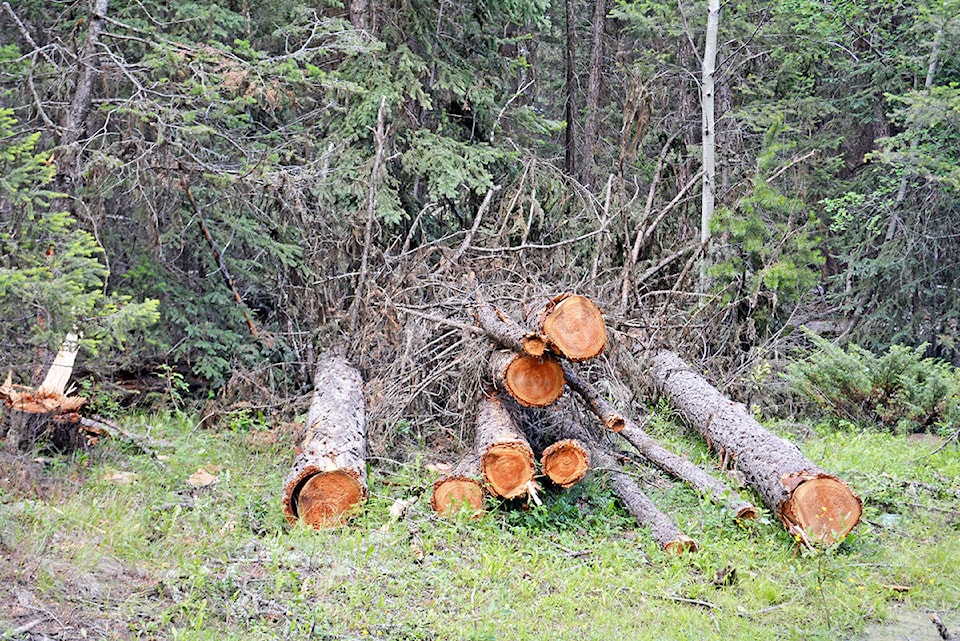Four years after its inception the City of Williams Lake and Williams Lake Indian Band have profited for the first time from their joint Community Forest Agreement Tenure.
In June the City received a cheque in the amount of $987,000 and the WLIB received $861,000.
Steve Capling, Community Forest board chair, said the cheques covered both a dividend and a repayment of previous loans and costs associated with setting up the Community Forest.
At its regular meeting on June 26, city council passed a motion asking staff to put the money into a reserve fund and bring forward a report on how it can be managed in the future.
“The idea is to have it earmarked so that it doesn’t just end up in general revenue without being able to identify the projects that it goes toward,” Mayor Walt Cobb said.
Coun. Sue Zacharias said there is also a community fund for people living in the areas adjacent to the community forest’s blocks to apply to for community projects.
“The Williams Lake Indian Band and the City have realized a great profit and there is provision in the community forest to return part of the investment to the communities,” Zacharias said.
Chief Ann Louie of the Williams Lake Indian Band said she is grateful for the community forest license and joint partnership with the City of Williams Lake.
“This has been a journey over a number of years to secure the CFL,” she told the Tribune. “Now to finally see benefits flowing to the band from the CFL will assist us with programs within the community such as our elders centre and areas where we receive no funding.”
Proper financial planning will be beneficial for the band for years, she added, noting proper forest management and planning with assistance of great managers and directors benefits everyone including the rural areas who can apply for grants that have been set aside by the City and the Band.
“This CFL also provides good paying jobs to local members and area residents,” she added.
Community forest manager Hugh Flinton said the forest’s fiscal year runs Jan. 1 to Dec. 31 and the payments to the two shareholders came from 2017.
Read more: Williams Lake Community Forest under new management
In 2014 there was no harvest, in 2015 the harvest was 1,023 cubic metres, in 2016 it was 17,859 cubic metres and in 2017 the harvest was 81,000 cubic metres.
“The community forest has an annual allowable cut of 40,000 cubic metres for both blocks put together,” Flinton said, adding the bulk of the AAC had to come in 2017 and 2018 because after the Community Forest Agreement was signed in 2014 it took a few years to do the planning required for harvesting.
An AAC can be rolled forward, but cannot be carried forward after a five-year period is up, he added.
In 2018, the plan is to harvest another 100,000 cubic metres, Flinton confirmed.
Presently the board consists of Leah Hartley, Tom Foley and Tammy Tugnum representing the City and Gabe Pukacz and Byron Louie representing Williams Lake Indian Band.
Education continues to be a focus and more than 200 area students visited the community forest during the 2017/18 school year.
Funded projects such as habitat enhancement in the mule deer winter range with help from the Forest Enhancement Society of B.C., fertilization projects in the Potato Mountain block in the Big Lake area to help grow trees faster and mitigate mid-term timber supply issues, and pine spacing in young pine stands in the Big Lake area, funded by the community forest itself continue, as well as fuel mitigation.
They also installed Douglas-fir bark beetle traps in April, hoping to stop the spread of the beetles.
Read more: Williams Lake Community Forest focuses on fir-beetle, wildfire mitigation and education
“We’ve been really fortunate with an upturn in the lumber markets that have coincided with our five-year harvesting pattern,” Flinton said. “We have harvested the bulk of our annual allowable cut at a time when the log markets are at record highs.”
Of the logs harvested, 99 per cent have gone to local Tolko and West Fraser mills and log home and timber frame manufacturers.
“One per cent no one could use locally so we shipped them to the coast,” Flinton noted.
Over the winter biomass from harvest debris from fuel management areas around Williams Lake went to Atlantic Power Corporation’s biomass-fired generating facility in Williams Lake and last week a shipment of material went to Pinnacle Pellet, and a little bit of material to the Norbord OSB mill in 100 Mile House.
news@wltribune.com
Like us on Facebook and follow us on Twitter
